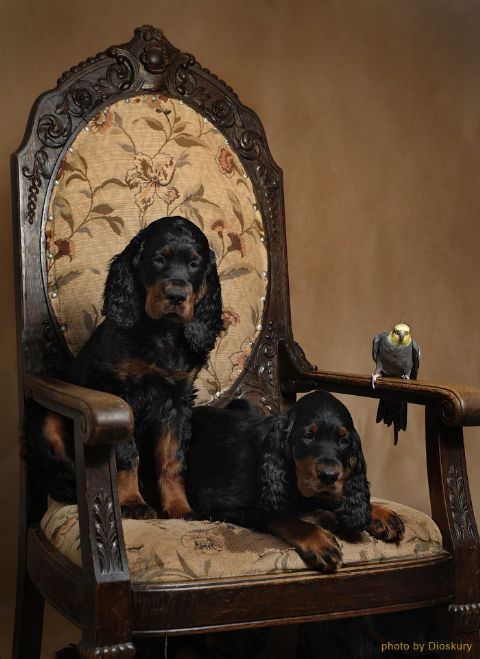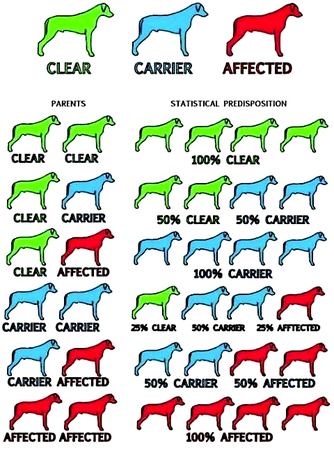Gordon Setter Health & Colour

Please note, the photograph shown above is subject to copyright and may not be copied or reproduced.
Late onset PRA in Gordon Setters
PRA (progressive retinal atrophy) refers to a group of inheritable eye diseases which affect the retina,there is no cure available at the present time and affected dogs will suffer progressive loss of vision eventually leading to total blindness. Many breeds of dog are predisposed to this condition, but the age of onset can vary, some breeds will become affected at a very early age whereas others may not develop symptoms until middle age or sometimes even older. The cause of PRA is an autosomal recessive mutation, therefore a dog must acquire two copies of the mutation, one from its sire and one from its dam to become AFFECTED. If a dog has only one copy of the mutation and one normal copy of DNA it will be a CARRIER, which means that although the dog itself won't develop PRA during its lifetime, it will pass the mutation to approximately 50% of its offspring. A dog with two normal copies of DNA is CLEAR and will not develop PRA nor pass it on to its offspring.

A form of PRA that has been termed "late onset PRA" was discovered in Gordon Setters in 2011. Fortunately the Animal Health Trust in the U.K. has identified the mutation (which they have named rcd4) involved in most cases of PRA in the breed and a simple DNA teat is now available from many testing laboratories around the world. Providing one parent in every mating is Clear the chance of Affected puppies being born will be eliminated.
Hip (and Elbow) Dysplasia
Hip Dysplasia (HD) is the malformation of the development of one or both ball and socket joints in the hip. The hip joint is composed of the socket, which is formed by the bones of the pelvis, and the "ball" (head) of the thigh bone (femur). Normally, this joint is very tight fitting, however if suffering from dysplasia there will be too much movement in the joint resulting in wear of the joint resulting in pain and lameness. The degree of hip dysplasia present is indicated by a score assigned to each hip. Using the BVA/AVA system the hip score is the sum of the points awarded for each of nine aspects of the X-rays of both hip joints. The minimum hip score is 0 and the maximum is 106 (53 for each hip). The lower the score the less the degree of hip dysplasia present. In the UK an average (or mean) score is calculated for each breed scored under the scheme and advice for breeders is to use only breeding stock with scores well below the breed mean score.
The minimum age for hip scoring is one year, and each dog is only ever scored once under the scheme. Hip (HD) and Elbow Dysplasia (ED) is a multifactoral, genetically based disease which is greatly influenced by environmental factors. The modes of inheritance of HD and ED are complex and the degenerative changes occur with growth if the unfavorable genetic and environmental factors are present. Due to this complexity, normal hipped/elbowed dogs can produce offspring with all degrees of dysplasia and dysplastic dogs can produce normal offspring.
The Gordon Setter clubs of NSW and Victoria encourage all breeders to X-Ray and score the hips of at least, all their breeding stock. To look up the scores that have been submitted to the NSW club click here. The lower the score per hip/elbow, the better. In Australia the breed mean score was 11.3 in 2004.
Treatment of HD is directed at the alleviation of pain, and in severe cases involves major (and expensive) surgery to replace the joint.
For more information please contact your dogs breeder.
Source: Gordon Setter Club of NSW
Gastric Dilation Volvulus (GDV) - More commonly known as "Bloat"
BLOAT IS AN EMERGENCY - The technical name for bloat is "Gastric Dilatation-Volvulus" ("GDV"). Bloating of the stomach is often related to swallowed air (although food and fluid can also be present). It usually happens when there's an abnormal accumulation of air, fluid, and/or foam in the stomach ("gastric dilatation"). Stress can be a significant contributing factor also. Bloat can occur with or without "volvulus" (twisting). As the stomach swells, it may rotate 90° to 360°, twisting between its fixed attachments at the esophagus (food tube) and at the duodenum (the upper intestine). The twisting stomach traps air, food, and water in the stomach. The bloated stomach obstructs veins in the abdomen, leading to low blood pressure, shock, and damage to internal organs. The combined effect can quickly kill a dog. It is frequently reported that deep-chested dogs, such as German Shepherds, Great Danes, and Dobermanns are particularly at risk.
Symptoms of Bloat:
The dog may have an obviously distended stomach especially near the ribs but this is not always evident depending on the dog's body configuration.
The biggest clue is the vomiting: the pet appears highly nauseated and is retching but little is coming up. If this is seen, rush your dog to the veterinarian IMMEDIATELY for stomach decompression and shock management.
Bloated dogs, once stable, should have surgery. Without surgery, the damage done inside cannot be assessed or repaired plus bloat may recur at any point, even within the next few hours. Surgery, called gastropexy, allows the stomach to be tacked into the normal position so that it may never again twist. Without gastropexy, the recurrence rate of bloat may be as high as 75%!
Source: Gordon Setter Club of NSW
Please note that Liver or Red coat colours in Gordon Setters, is not a health issue!
As most of us know the Gordon Setter is black and tan - however like many other predominantly black and tan breeds, it is possible to get liver and tans, reds, red and tans, and even tricolours with a mostly white background. The liver colour is similar to that which is sometimes called chocolate or brown in other breeds, and the red is similar to the colour of an Irish Setter.
Because liver and red are both recessive genes it has proved impossible to completely eliminate the genes from the Gordon.
What is the effect of recessive colour genes in the Gordon Setter? If a black and tan (b&t) Gordon who is a carrier of the recessive red gene is mated to another b&t Gordon who is also a carrier of the recessive red gene then about 25% of the resulting litter will be red instead of b&t. So in a litter of 8 puppies you would probably have about 2 red puppies. If a carrier for red is mated to a non carrier for red then all the puppies will be b&t but about 50% will be carriers of the recessive red gene. In the first example where both parent are carriers of the recessive red gene about 66% of the b&t puppies will be carriers of the recessive red gene. In other words in our litter of 8, on average 2 will be red, 4 will be b&t but carrying the recessive red gene and 2 will be b&t and not carrying the recessive red gene. (Please note the use of terms such as 'about' and 'on average'. The inheritance of genetic characteristics is the probability of an event happening based on large sample sizes and the actual percentages can vary considerably if the sample size is small.)
In the past it was difficult to know if a particular dog was a carrier of a recessive red or liver gene, but things have now changed with the development of gene technology which can determine if a Gordon carries the recessive liver or red genes. The test is available from Vet Gen in the USA. See information on websites for full details - the cost at May 2011 using the Australian agent "Gen Test" is approximately AUD $109.00 see www.vetgen.com or http://members.optusnet.com.au/~gentest
Source: Gordon Setter Club of NSW
Contact Details
Steve,Carolyn,Laura Bennett + Sarah Auld & FamilyAdelaide Hills, SA, Australia
Phone : +61414930223
Email : [email protected]
